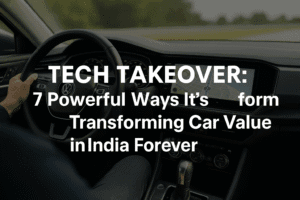Tech Takeover: 7 Powerful Ways It’s Transforming Car Value in India Forever
Technology is fundamentally redefining value in India’s car market. Features like advanced safety systems (lane assist, automatic braking) and connected conveniences (remote AC, app control), once exclusive to luxury cars over ₹50 lakh, are now standard in mainstream models like the Honda Amaze and Mahindra XUV700 starting around ₹9-12 lakh, dramatically recalibrating consumer expectations.
Luxury brands like BMW and Mercedes are responding with immersive experiences (massive screens, AI learning systems) and sophisticated connected platforms offering real-time safety data and over-the-air updates. Crucially, tech has shifted from a differentiator to a necessity; buyers now prioritize tangible, daily-use experiences – intuitive interfaces, reliable safety aids, genuine convenience – over abstract mechanical specs. This elevates brands perceived as truly integrating tech usefully, like Mahindra. Success now hinges on seamless, practical technology deeply woven into the realities of Indian driving, making the car itself a constantly evolving digital experience.

Tech Takeover: 7 Powerful Ways It’s Transforming Car Value in India Forever
Gone are the days when a car’s worth was measured solely by engine size or fuel efficiency. In India’s rapidly evolving automotive landscape, technology has become the new currency of value, fundamentally altering what consumers expect, how manufacturers compete, and what it means to own a vehicle. This isn’t just about adding screens; it’s a profound shift in priorities reshaping the market from the ground up.
Democratising the Driving Experience: Tech for the Masses
The most striking change is the trickle-down revolution. Features once considered the exclusive domain of luxury sedans costing upwards of ₹50 lakh are now appearing in cars accessible to the average Indian family:
- Honda’s Amaze and Mahindra’s XUV700 are prime examples. Suddenly, ₹9-12 lakh buys you:
- Enhanced Safety: Lane-keep assistance, autonomous emergency braking, and adaptive cruise control – actively protecting occupants.
- Effortless Convenience: 360-degree cameras easing parking in tight urban spaces, remote AC activation via smartphone before you even step inside on a scorching day, and seamless mobile app integration for vehicle monitoring and control.
- The Implication: This isn’t just a price drop; it’s a recalibration of expectations. Consumers now see these advanced driver-assistance systems (ADAS) and connected features not as luxuries, but as essential components of a modern, safe, and convenient car. The perceived value gap between mainstream and premium is narrowing dramatically.
Luxury’s Response: Beyond Opulence to Immersive Intelligence
Luxury brands aren’t standing still. Faced with mainstream advancements, they’re pushing boundaries to redefine exclusivity through deeply integrated, experiential tech:
- BMW‘s i7: Features an 8K ‘Theatre Screen’, transforming the rear cabin into a personal entertainment hub – a statement about in-car lifestyle.
- Mercedes-Benz EQS SUV: Showcases a breathtaking 56-inch ‘Hyperscreen’ and crucially, a generative AI-based operating system. This system learns driver habits, anticipating needs and personalising the driving environment over time.
- The Connected Core: Both brands (and others) now offer sophisticated connected car platforms. This enables:
- Real-time data sharing: For enhanced road safety (e.g., hazard warnings) and laying the groundwork for future autonomous capabilities.
- Over-the-Air (OTA) Updates: Cars can improve and gain new features after purchase, much like a smartphone, ensuring the vehicle evolves and remains relevant.
The Consumer Mindset Shift: Experience Trumps Spec Sheets
This tech surge is fundamentally changing how Indians choose their cars:
- From Differentiator to Necessity: As experts note, advanced tech is no longer just a “nice-to-have” selling point. It’s rapidly becoming a table-stakes requirement for serious consideration. A car lacking core connectivity or basic ADAS feels increasingly outdated.
- The Power of the Tangible: Consumers are less swayed by abstract mechanical specifications (horsepower figures discussed in showrooms) and far more influenced by visible, experiential technology they can interact with daily. The intuitive feel of the infotainment, the confidence boost from safety alerts, the sheer convenience of remote features – these create lasting impressions.
- Tech as a Brand Elevator: Mahindra’s success demonstrates this perfectly. Their aggressive tech integration, particularly in the XUV700 and Scorpio N, has significantly boosted their brand perception, positioning them as innovative and premium in the eyes of consumers, rivalling traditional players.
- Prioritising Practical Usefulness: Flashy gimmicks won’t win long-term. The key to future market leadership lies in how seamlessly, reliably, and usefully these technologies integrate into the actual Indian driving experience. Does the lane-keep assist handle chaotic city traffic well? Is the voice command system robust enough for Indian accents? Does the app provide genuine value beyond novelty? These are the questions that will determine winners.
The Road Ahead: Integration is King
The Indian car market’s tech transformation is far from over. The battleground now moves beyond simply packing in features. Success hinges on:
- Deep Integration: Technologies must work together harmoniously, not as isolated functions.
- User-Centric Design: Interfaces must be intuitive, minimizing distraction and maximizing utility for Indian users and conditions.
- Reliability & Security: As cars become rolling computers, robust cybersecurity and dependable performance are non-negotiable.
- Evolving Value: OTA updates offer the potential for cars to grow in capability, extending their value proposition over time.
In essence, technology is no longer an add-on; it’s the very fabric of the modern Indian car. It’s democratising safety and convenience, forcing luxury to innovate harder, and compelling buyers to prioritise the digital experience alongside the mechanical one. The manufacturers who understand that tech’s true value lies not in its existence, but in its thoughtful, practical, and seamless integration into the realities of Indian life, will be the ones driving the future.
You must be logged in to post a comment.